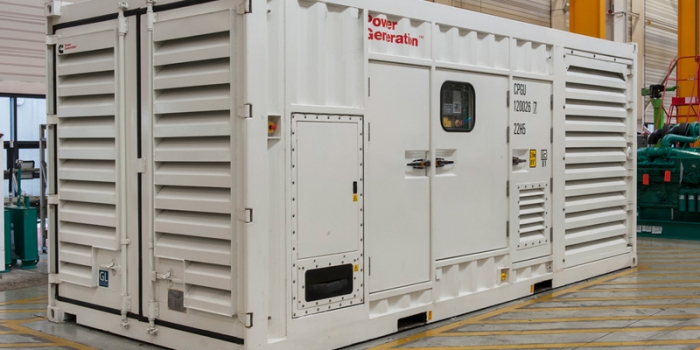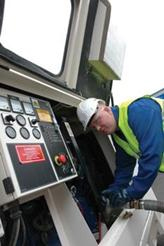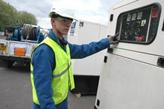ESE installs two 1675KVA generators in under 2 mins!
https://youtu.be/lqG72PFUj2E

The use of transportable diesel generator sets to provide temporary mains-independent power has become commonplace in a huge range of applications, from outdoor public entertainment events to large construction sites. Regarded almost as a ‘fit and forget’ item that merely needs periodic refuelling and minimal maintenance, the diesel genset is expected to operate continuously, quietly, efficiently and with total reliability for extended periods, often under arduous conditions.
 Generator hire companies are capable of supplying transportable generator sets to meet virtually all possible requirements for mains-independent power, either for short-term site requirements or under long-term contracts. The equipment supplied will be chosen to conform to the specification supplied by the customer. It is therefore essential that this specification is matched accurately to the application.
Generator hire companies are capable of supplying transportable generator sets to meet virtually all possible requirements for mains-independent power, either for short-term site requirements or under long-term contracts. The equipment supplied will be chosen to conform to the specification supplied by the customer. It is therefore essential that this specification is matched accurately to the application.
The fundamental difference between conventional mains power from a supply utility and electricity from a mains-independent generator set, means that it is not sufficient to select a generator simply in terms of the total aggregate power ratings of all connected equipment. The public mains supply is an inherently low impedance system. If non-linear loads such as computers, electronic ballasts in fluorescent lighting, electronically-controlled variable speed drives and uninterruptible power supply (UPS) systems are connected causing harmonic distortion of the current, the voltage waveform will not be affected to any significant extent and will remain effectively sinusoidal.
The source impedance of a temporary, mains-independent supply from a diesel generator set is significantly higher than the public alternating supply. When non-linear loads are connected, they will create harmonics on the supply frequency, resulting in greater distortion of the sinusoidal voltage waveform.
While the majority of modern generator sets can cope with a reasonable level of harmonic distortion, the load being supplied may not be so forgiving. To avoid potential problems, including damage to connected equipment, it is necessary to let the genset supplier know what level of voltage distortion their equipment can withstand.
 At the same time, increasing the size of the generator in terms of its power output rating will lower the source impedance of the supply, consequently reducing the effects of harmonic distortion. This means that the larger the generator, the lower the source impedance, although an increase in size will always result in the rated output being higher than an equivalent mains supply.
At the same time, increasing the size of the generator in terms of its power output rating will lower the source impedance of the supply, consequently reducing the effects of harmonic distortion. This means that the larger the generator, the lower the source impedance, although an increase in size will always result in the rated output being higher than an equivalent mains supply.
If a generator is not rated correctly, the load being supplied, or its components, could be damaged by the effects of harmonic distortion and the performance of equipment affected. The efficiency of wound components, such as electric motors and transformers, will be reduced by increased operating temperatures, acoustic noise and overstressed insulation, leading to reduced life.
High frequency harmonics cause excessive current flow and premature failure of capacitors and high peak voltages can also cause dielectric breakdown. Problems can also be encountered on cable runs, particularly in high-density containments, where increased operating temperatures will reduce life and increase fire risks. Circuit-breakers will tend to experience increased levels of nuisance tripping while harmonics can also result in interference being picked up by other equipment, which in turn can cause unstable operation or malfunction.
Increasing the acceptable voltage distortion level can result in a significant reduction in the size and rating of the required generator, but the higher the ‘acceptable’ distortion level, the greater the possibility of long-term damage to equipment connected to the supply.
In practical terms it may be difficult to obtain accurate and objective information on harmonic distortion from manufacturers of the plant and equipment connected to the supply from the generator. However, useful guidelines on distortion levels are available in Engineering Recommendations G5/4 available from the Energy Networks Association, which define the permissible levels guaranteed by regional supply utilities for harmonic distortion on public electricity supplies in the UK.
Less stringent European guidelines are outlined in British Standard BS EN 50160 and the standards for public supplies in North America are set out in IEEE 519. These provide an excellent indication of the equivalent acceptable levels of harmonic distortion on a mains-independent supply from a generator set.
The inherent dangers of using a generating set with insufficient capacity to provide mains-independent power, where a proportion of the systems and equipment represent a non-linear load, make correct specification imperative. The potential problems of using a generator with inadequate power output rating, in terms of possible damage to expensive plant and equipment as well as for subsequent health and safety issues, could have catastrophic commercial consequences for a contractor or other end-user.
On the other hand, if the generator is too large, it will be unnecessarily expensive in terms of initial outlay and running costs. It is therefore vitally important that the temporary on-site power requirements are given very careful consideration. Close consultation with the plant and equipment manufacturers and of course with the generator set hire company or supplier will ensure that on-site power is provided with the same levels of availability and reliability as the public mains supply, preventing overheated finances as well as damaged equipment.
In a recent enquiry received by LCH Generators, a temporary ac power supply was required by the customer for a UPS system prior to the local regional electricity company installing a permanent on-site mains supply. After queries concerning the specifications and main operating parameters of this non-linear load, it was determined that the system was based on solid-state switching devices operating in six-pulse mode. This is numerically proportional to the arrangement of two, six or 12 thyristors or other electronic switches that conduct successively during one cycle of the alternating supply.
With an operating voltage of 400 V, 50 Hz and a power rating of 325 kVA, the UPS was capable of operating with 10% voltage distortion without affecting its performance. It produced a level of current distortion of 30%, a measured value supplied by the manufacturer. The operating efficiency was 98•3% and the power factor was 0•9.
Using the information from the customer in conjunction with relevant specifications from the alternator manufacturer, LCH was able to determine that to limit voltage distortion to the required 10%, the necessary sub-transient reactance for the six-pulse UPS was 3•5%. This enabled the loading factor to be calculated as 3•5/12 = 0•29. Dividing the power rating of the load (325 kVA) by the loading factor provided a figure of 1121 kVA for the alternator output.
The company was able subsequently to provide a standard 1260 kVA genset from its nearest local fleet depot, meeting the customer needs in full.
This article first appeared online in Building Magazine